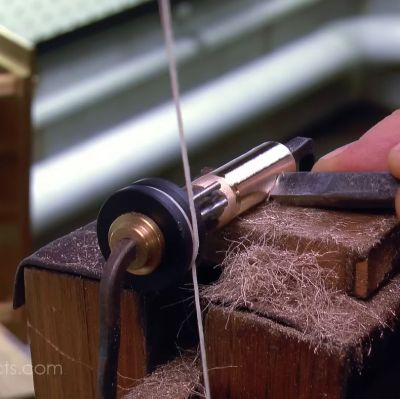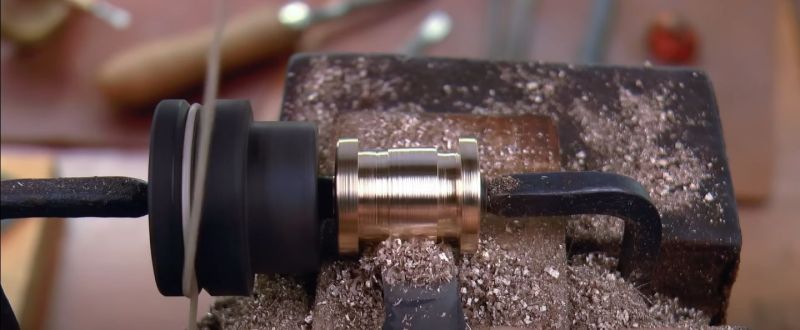
We commonly tend to associate lathes with the Industrial Revolution, when metalworking shifted largely from blacksmiths to machinists, but the use of lathes is much older than that. As [Chris] over at the Clickspring YouTube channel demonstrates in a recent video, small precision lathes were exceedingly common in the Ancient World. Not only is there ample historical evidence of them being used as far back as 1300 BCE in Ancient Egypt, but they’re also the most optimal way to get perfectly round pins and other, more intricate shapes that would be an absolute nightmare to create with just some metal files and chisels.
In the video, [Chris] uses two metal hooks, bent in a ninety-degree angle and clamped down in a vise, tapering towards each other into points. A bow string around a round piece of wood is used to bootstrap a more permanent retention element and bushing for the bow string as it is drawn over the wood to rotate it. Subsequent material that has to be worked on in the lathe is then clamped between the two points. This way, using basic materials that have been around for thousands of years and some muscle power, it’s possible to create a small lathe that can be used to create perfectly symmetrical shapes, such as those used in the construction of the Antikythera Mechanism, which [Chris] has been rebuilding for the past years, using only period-correct tools. He’s learned a lot about the mechanism in the process.

















Been watching ClickSpring for a long time — absolutely fascinating!
Watchmakers and clockmakers used to use a rudimentary lathe similar, called “The Turns”. You can still buy them, but they are essentially just small between centers simple lathes like this, powered by a bow with a string. You have to use a hand graver just like he does in the video.
You’re not going to do any complex work, but you can still do simple turning very precisely if you’re good.
“small precision lathes were exceedingly common in the Ancient World.”
Exceedingly common? That’s a bit of a stretch. I think we’d be seeing a whole lot more small cylindrical artifacts if they were in fact exceedingly common. Okay, sure, somebody was using them in ancient Egypt. But I don’t see any huge pyramids in ancient Greece. I think [Chris] is right, the builder of the Antikythera mechanism must have used a lathe of some sort, but I think he would have been an exceedingly skilled machinist for his time, using tools that themselves were exceptional.
Many egyptian stone vases look like they were turned, with sub millimeter roundness. There were also kid toys with turned stone wheels. Using a lathe to make toys is enough for me to classify them as exceedingly common.
You don’t exactly need a lathe to build huge pyramids and you don’t need huge pyramids to have lathes…
There are lots of very round finds in the ancient world.
One that stands out to me is those weird Roman dodecahedron things with all the spheres around the edges – and those actually start to suggest a much more developed Lathe than Clickspring’s example as such neat and similar spherical shapes imply a ball turner, or perhaps a form tool and a lathe with more driving power so it can handle the large cutting area. And then creating such neat polyhedral shapes that seem from what I’ve seen to be very very regular are rather suggestive of pretty capable machine tooling – they do appear to be folded or just soldered sheet metal shapes but getting those angles so neat implies some form of jig for assembly, and with all those circular features engraved on the faces of them and so well aligned to the centre of the shape.
No idea what they are supposed to be, or how they were really made – far as I know nobody with the machinist mindset has ever tried to recreate one from decent historical examples and all the information we can get from them with modern imaging techniques.
Some knitters sugested those dodecahedrons are ideal for knitting glove fingers and finding them near mountains is not a coincidence.
https://www.youtube.com/watch?v=amLeEmU6I-M
Indeed, though there are so many theory, many that sound plausible and to my limited knowledge nobody really has any good evidence for anything beyond the time period they came from.
For all we know its just the paperweight design of choice for a while – we know the folks of the past had plenty of vanity and appreciation for pretty things from the archaeology, no reason to believe it absolutely must be a practical object in some way. (Though personally I do think they must have had some purpose as if there were just ornamentation surely there would be more variations on the theme found in the way there are Christian crosses etc)
I made an “Egyptian lock” about a decade ago, deliberately using only the basic hand tools of chisel, drill and saw. Taught me that a lot of the people taking about the ancient locks are talking nonsense, and also explaining very vividly why the design changed as it travelled north.
One of those weird hairbrush like keys?
It’s funny but. As soon as you mentioned it. I saw them as alignment tools. Spindle through holes and multiple alignments based on tying from the balls to the work. So multiple tie downs. Center a drill in a stack of these, averages would probably work well. Both for large and fine alignment. I wonder if they have any working marks on them.
Actually, if you think about two things you might find it a reasonable statement.
Both are the result of one fact. As far as we know, the ancient world did not have practical combustion engines or electric motors. Yes, I do know about Hero’s steam engine, which is why I say that they didn’t have practical engines. So, because ancient lathes they were not powered by combustion engines or electric motors two things follow: First , they could not produce work as quickly as we can now, so they would have needed more lathes to produce the artifacts w have them if we were making them now. Second, for anything larger than tiny parts like pins they needed a mill (water or conceivably wind) or draft animals to turn metal or stone. So most of what was turned was probably wood, similar to the rest of history before the industrial revolution, and most of that didn’t survive, just like during the rest of history. And we know that sophisticated lathe work took place during the Renaissance and Middle Ages because we have records. There are even a few existing examples of oval turning from the Renaissance and that is still a challenge. (Technically more elliptical).
This could be a overdesigned cinnamondispenser.
I like it!
Love the clickspring series.
What I don’t understand, even today when watchmakers work on the Turns, is why not rig up a foot pedal like on an old sewing machine and then you don’t have to fuss with the bow and also, you can use both hands to do things. Even if that wasn’t possible for whatever reason, having an assistant turn a crank so that the direction of rotation stays constant would be plenty easy, as demonstrated by the Gunsmith of Williamsburg video posted here at HaD a while ago.
And I know there is a huge difference between ancient BC and early gunsmith techniques but.. not really.
Foot powered sewing machine tables are so common at flea markets as to be practically free, and so common you see them repurposed as customers’ tables at a not-insignificant number of roadside diners and dives.
I really believe that we are no “smarter” today than when the mechanism was built- we just have better tools that make it easier and fastere. But when manual labor costs are zero, and you aren’t working on a production line, I’m not surprised at all that things like this exist. I love it.
They’re probably using a bow for authenticity, I expect if they’d found evidence of foot driven mechanisms from the period, they would use them.
Also, manual labour is not zero cost, at the very least, your labourer needs food and water to keep them nourished, housing and bedding too. Even if you’re doing it yourself, these things are a cost consideration.
The main reason is that people didn’t use to have so much furniture. Work was done sitting on the ground, while a foot pedal lathe would have required a table and a chair. Too fancy, too expensive. Instead, people actually did a lot of the work with their feet as well, using their toes to hold stuff down.
I’ve seen an Egyptian dude turn chess pieces with a stick between his toes and a bow to turn it.
Similar video:
https://www.youtube.com/watch?v=Vw7nnEb6X04
The guy is using the bow to turn the stick, his foot to steady the tool, and his other hand to move it around. That’s a local maximum point in evolution of that tool: if you add the foot pedal, it gets worse, until you add a proper tool rest and a frame around the whole thing – but then it gets more expensive to construct the tool.
Oh, and he’s also using his other foot to hold the lathe down to the floor, so he’s got no free appendages left over to pedal the thing. All four limbs in use.
Foot powered lathes were common in ancient India, and there were traveling lathe workers who would visit towns and do lathe work before moving on to the next town.
The lathe worker would tie the string to a branch in a tree, down to a treadle on the ground. Stepping on the treadle would lower the branch and then releasing would cause the branch to spring back up. Wind the string once around a workpiece held at each end by a dead center and the work will spin as needed.
It might be a case of things invented in different areas, or different environments. The foot treadle lathe might have been inspired by the springiness of branches seen in jungle trees, but trees in Greece and Italy might have been fewer and smaller… closer to bushes.
Townsend uses a foot poweder model here: https://youtu.be/IShxXtAev9U
But thats a later version of a lathe. Not really technologically, but in terms of when we see them made. That’s what makes Clickspring and Townsend different than say, Primitive Technology. Primitive Technology has a limit of ‘any tech, so long as I start from punching the tree’ so you see methods from the middle ages used beside methods from prehistory, while Clickspring will buy abrasives, metal stock, wood, leather etc, appropriate to what could be available at the time and then make all the tooling, jigs, and product in ways that also might be appropriate to the time based on what documentation is available. More like a historical research peice.
Why bother at all then? Slap an electric drill onto it. Or just buy 1200 of them from a machine shop, turned out by cnc.
Also, the entire point of it being foot driven is that you still have both hands free.
I’d suspect they use a hand bow as it probably gives you a good feel for the cutting forces involved and the parts they tend to work on are tiny – so perhaps you really really want the sensitivity of your hands on both cutting tool and power?
I’ve never used anything but electric powered lathe but that seems rather reasonable to me. I know my feet are darn nearly numb in comparison to my hands – got lots of power available but so much less feeling that for delicate jobs…
This guy’s toolmaking ability is astounding. The simplicity, the almost effortless attention to ergonomics, the flexibility of his tools, high precision produced from nothing. Makes me wonder just how far back clockmaking really goes. As he says, the Antikythera clearly isn’t a craftsman’s first project nor the result of a young technique.
I’ve been talking with Chris for a decade and he’s the most humble artisan I’ve ever spoken with. Not only is he a master clockmaker, but a genuinely good guy to boot. Willing to provide help, feedback or just a friendly chat, he’s the greatest bloke I’ve met that side of the equator.
Knowing that because of his expertise, he published a scientific piece about previously unknown function of the antikytheria mechanism (from his recreation efforts) is just the cherry on top.
Truly wish more humble gents like him existed.
Before I owned a lathe I would drill a hole in whatever I wanted to turn down, then put it on a screw driver with small washer first then material andmy thumb nail as a stop against the washer then spin the material with pressure from a Dremel. Not at all surprised a string replaced the Dremel thousands of years before me.
Most probablly the lathe is as old ald as potter’s wheel no any wonder that is mentioned in the bible at least 2 times. Funny thing is that a potter’s wheel is a vertical axis simple machine not an orizontal one
I’d suspect the lathe is far far older. At least if you are talking working on wood – really simple to make a basic wood lathe in the field even and the resources to do so are in a stone age world nearly globally universal (at least on land).
Pottery is a little more refined of a process so probably doesn’t exist at all until after the wood lathe and doesn’t actually require a pottery wheel to be made, so even if it was contemporary discovery the pottery wheel very likely isn’t coming first – If only because the wood lathe would make it much easier to make a smooth running pottery wheel and to have the idea for one is pretty close to having the idea for both.
Both however at least in a basic form have to be very very old technologies.
Both the lathe and the potter’s wheel consist of two supports which allow rotating the object in between. Axis of orientation is irrelevant. The construction of a potter’s wheel would simply involve turning the table and kick wheel on a vertical axis. Logically they would have been contemporaneous developments.